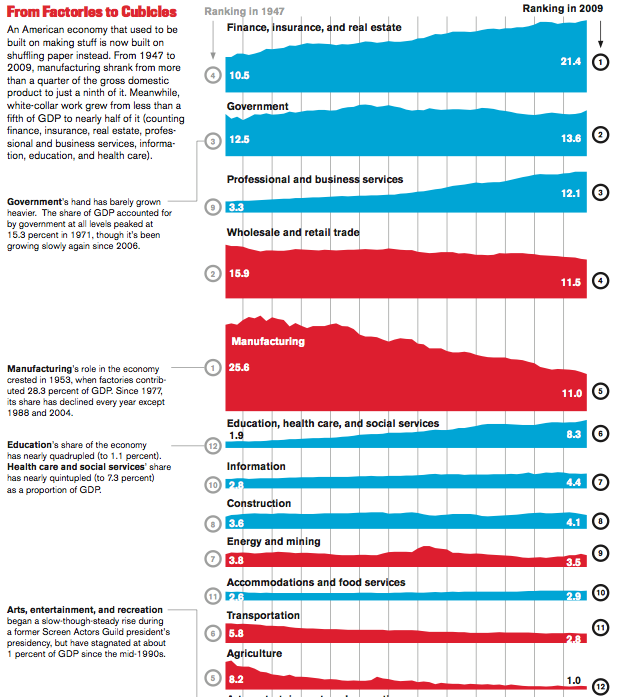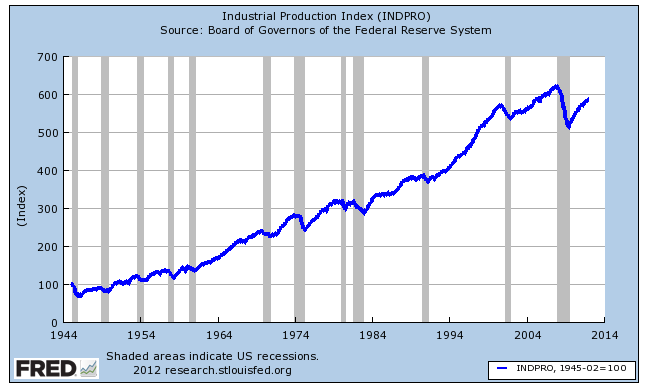How Did The American Workforce Change During The 1950's
Where Did All the Workers Go? 60 Years of Economical Change in ane Graph
President Obama'southward Country of the Union oral communication was surprisingly bullish on reviving manufacturing, prompting one very clever person on Twitter to say something along the lines of: "Democrats want the economic system of the 1950s, while Republicans just want to live in that location."
It got me thinking: What did the economy expect like in the 1950s? If y'all could organize all the jobs into buckets and compare the paper-shuffling professional services saucepan to the manufacturing bucket, what would they look like around 1950, and how has the picture changed in the final sixty years?
National Journal addressed just this topic in its special written report on the rise and fall and ascent of manufacturing. The spectacular graphic compares employment by sector in 1947 and 2007 and its most of import lesson is a whopper. Manufacturing and agriculture employed one in three workers simply after Globe War 2. Today, those sectors use only one in eight.

Where did all the making-stuff and growing-stuff jobs become? They went into services.
The champion in the concluding vi decades was finance, insurance and real estate, which doubled its share of employment from x.five% to 21.4%. Only the broader service industry -- including professional and business services (a wide catch-all with marketing, managing, consulting, computer services) and health and education services -- also grew from about thirteen% to most thirty%. Everything else has stayed pretty much the same. Government, wholesale/retail, data, and construction business relationship for a little more than a tertiary of the economy today, and they deemed for a little more than a third of the economy threescore years ago.
The large story about American jobs in the post-war period is this: The manufacturing/agronomics economy shrunk from 33% to 12%, and the services economy grew from 24% to fifty%. I don't desire to leave you with a facile explanation, simply for the purposes of space, I think information technology'southward adequate to say that every bit manufacturing and agriculture got more efficient, they required fewer American workers, while the services industry (which had slower efficiency gains since it has more person-to-person work) required more than employees to keep up with the rising demand for consulting, nurses, teachers, computer technicians, and and then on. This isn't a sorry story, or a happy story. It'southward but what's happening, and information technology's not accurate to think we can modify it very much by, say, creating a panel to annoy China's merchandise practices, as the president has proposed.
Closing thought: Why isn't everyone talking about the tragic pass up of agriculture? The industry'south share of workers has fallen past fourscore percent in the last 60 years. Nobody seems to think that'southward much of a tragedy, but we exercise consider it tragic that manufacturing has lost 60 percent of its share over the same period. Are we being hyperbolic about the decline of manufacturing, in detail, or are we existence way too stoic about the greater loss in agronomics employment? Open up question.
Update: I should have made this signal more conspicuously: Manufacturing jobs accept declined as a share of the economy. But manufacturing hasn't declined every bit an industry. It'due south grown. By a lot. Here's total industrial product (manufacturing, utilities, and mining output) indexed to 1945. Output has sextupled.

Source: https://www.theatlantic.com/business/archive/2012/01/where-did-all-the-workers-go-60-years-of-economic-change-in-1-graph/252018/
Posted by: cooperhavine.blogspot.com


0 Response to "How Did The American Workforce Change During The 1950's"
Post a Comment